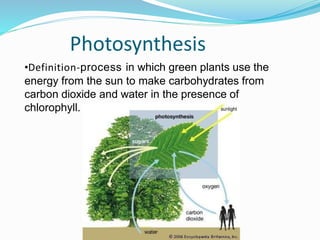Environment study
- 3. Definition of Oxygen • Oxygen – a colorless, odorless, tasteless gas • Denser than air • Poor conductor of heat and electricity
- 5. Step Two of Oxygen Cycle • Animals take in oxygen through the process of respiration. • Animals then break down sugars and food.
- 6. Step Three in Oxygen Cycle • Carbon dioxide is released by animals and used in plants in photosynthesis. • Oxygen is balanced between the atmosphere and the ocean.
- 8. History of Oxygen • Early evolution of Earth, oxygen released from H2O vapor by UV radiation and accumulated in the atmosphere as the hydrogen escaped into the earth's atmosphere • Photosynthesis became a source of oxygen • Oxygen released as organic carbon and gets buried in sediments.
- 10. Photosynthesis •Definition-process in which green plants use the energy from the sun to make carbohydrates from carbon dioxide and water in the presence of chlorophyll.
- 11. How is Photosynthesis Carried Out? •Photosynthesis only occurs in plants containing chlorophyll: •Water is absorbed by the roots and carried to the leaves by the xylem •Carbon dioxide is obtained from air that enters the leaves through the stomata and diffuses to the cells containing chlorophyll. •Chlorophyll is uniquely capable of converting the energy from light into a dormant form that can be stored and used when needed.
- 12. Steps in Photosynthesis • • • • • The light energy strikes the leaf, passes into the leaf and hits a chloroplast inside an individual cell The light energy, upon entering the chloroplasts, is captured by the chlorophyll inside a grana. Inside the grana some of the energy is used to split water into hydrogen and oxygen. The oxygen is released into the air. The hydrogen is taken to the stroma along with the grana's remaining light energy.
- 13. Steps Continued: • • • • Carbon dioxide enters the leaf and passes into the chloroplast. In the stroma the remaining light energy is used to combine hydrogen and carbon dioxide to make carbohydrates. The energyrich carbohydrates are carried to the plant's cells. The energyrich carbohydrates are used by the cells to drive the plant's life processes.
- 15. Respiration • Process by which an organism exchanges gases with its environment • Process → oxygen is abstracted from air, transported to cells for the oxidation of organic molecules while CO2and H2O, the products of oxidation, are returned to the environment
- 19. Earth’s Layers • The lithosphere is Earth's surrounding layer, composed of solids such as soil and rock. • The atmosphere is the surrounding thin layer of gas. • The hydrosphere refers to liquid environments such as lakes and oceans that lie between the lithosphere and atmosphere. • The biosphere's creation and continuous existence results from chemical, biological, and physical processes.
- 20. Today The Earth’s atmosphere consists of: • 21% Oxygen The Earth’s lithosphere consists of: • 99.5% Oxygen The Earth’s hydrosphere consists of: • 46.60% Oxygen The Earth’s biosphere consists of: • 0.01% Oxygen
- 21. Biological Importance of Oxygen • Humans need it to breathe • Needed for decomposition of organic waste • Water can dissolve oxygen and it is this dissolved oxygen that supports aquatic life.
- 22. Ecological Importance of Oxygen • Without oxygen at the bottom of the water body, anaerobic bacteria (those that live without oxygen) produce acids. These acids not only increase acidity, but also cause a massive release of phosphorus and nitrogen, two major fertilizers, from the organic sediment and into the water column. • These same anaerobic bacteria put toxic gases in the water including hydrogen sulfide (that rotten egg smell), ammonia, carbon dioxide and methane. These gases are all toxic to fish, beneficial bacteria and insects. • Lack of bottom oxygen is the cause of odors produced by anaerobic bacteria.
- 23. Ecological Importance of Oxygen Cont. • Lack of fish enables disease-hosting mosquitoes to thrive, as mosquitoes are natural food for fish. • Without oxygen at the bottom at all times, beneficial bacteria and insects cannot biodegrade the organic sediment. Large accumulations of organic sediment follow.























